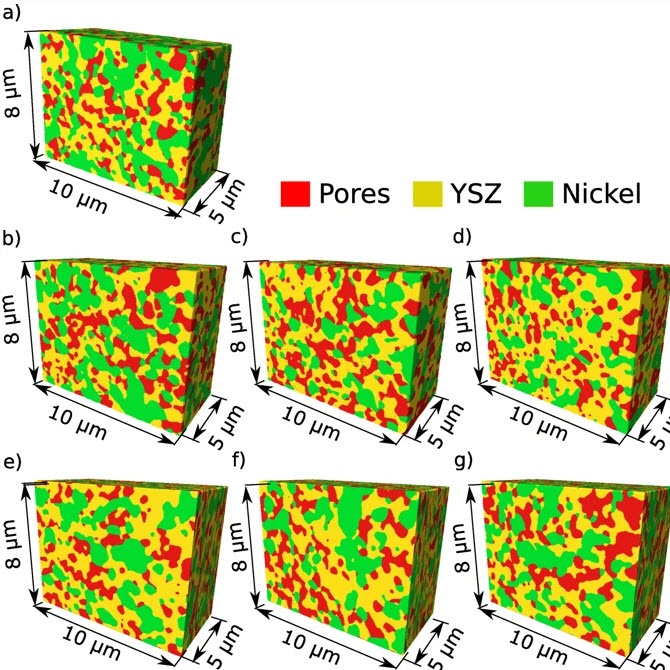Thermo Fisher Scientific › Electron Microscopy › Electron Microscopes › 3D Visualization, Analysis and EM Software › Use Case Gallery

A solid oxide fuel cell (SOFC) is an electrochemical device that converts the chemical energy of hydrogen directly into electricity. A single cell usually has a form of a flat plate in which an impervious and dense ion-conducting electrolyte is sandwiched between two porous catalytic electrodes: an anode and a cathode. Fuel is fed to the anode side, and the air is supplied to the cathode. The gasses cannot mix to avoid unproductive combustion. Instead, gasses hit catalyst material, lose their electrons, and form capacitors on both sides of an electrolyte. Because the reaction is slower on the cathode side, a potential difference appears between the two electrodes. This potential difference, together with an oxygen pressure gradient, is a driving force that moves oxygen ions from the cathode to the anode. In this respect, the morphology of the electrode microstructure is of crucial importance. A typical anode consists of a nickel phase (Ni), an yttria-stabilized zirconia phase (YSZ), and a pore phase. Each material plays an essential role in the transport processes across the SOFC by providing a pathway for different species. In the case of an anode, the YSZ phase provides pathways to oxygen ions, the Ni phase for electrons, and the pore phase allows gasses to penetrate the electrode. The electrochemical reaction can occur only at the line where all three phases are in contact, the so-called triple phases boundary (TPB). The presented research shows that the long-term operation of a solid oxide fuel cell can lead to substantial anisotropic changes in anode material. The morphology of microstructure in the investigated stack was observed before and after the aging test using electron nanotomography. The microstructural parameters were estimated based on the obtained digital representation of the anode microstructure. Anisotropy was discovered in two of the three phases that constitute the anode, namely nickel and pores. The third component of the anode, which is yttrium-stabilized zirconia, remains isotropic. The changes appear at the microscale and significantly affect the transport phenomena of electrons and gasses. The obtained results indicate that the reference anode material that represents the microstructure before the aging test has isotropic properties which evolve toward strong anisotropy after 3800 h of constant operation. The presented findings are crucial for a credible numerical simulation of solid oxide fuel cells. They indicate that all homogeneous models must adequately account for the microstructure parameters that define the anisotropy of transport phenomena, especially if microstructural data is taken from a post-operational anode.
Thermo Scientific Avizo Software is used to conduct triangulation and resempling in order to obtain 3D digital material representations of anode microstructure before and after the aging test.
For Research Use Only. Not for use in diagnostic procedures.